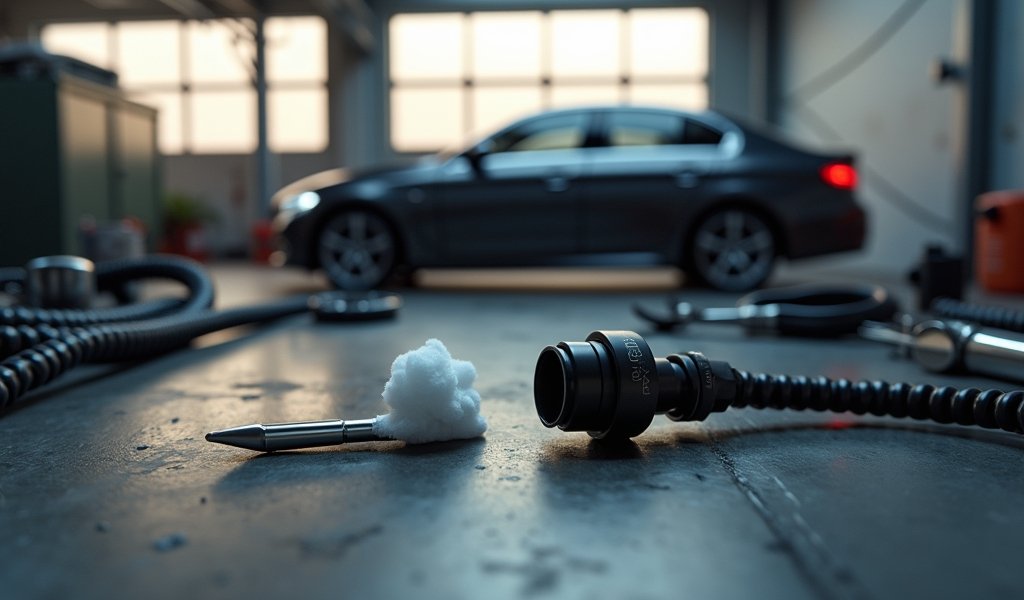Overview
This article provides a detailed guide on intake air temperature (IAT) sensors, explaining their function in monitoring air entering the engine to optimize fuel delivery, symptoms of failure, testing methods, and replacement procedures. It emphasizes that while small, IAT sensors play a crucial role in engine performance by allowing the ECU to adjust fuel mixtures based on air density, with proper maintenance ensuring consistent vehicle operation regardless of weather conditions.
Table of Contents
- Understanding the Intake Air Temperature Sensor
- Why Your IAT Sensor Matters
- Common Symptoms of a Failing IAT Sensor
- Testing Your Intake Air Temperature Sensor
- DIY Replacement Guide
- Maintenance Tips for Longevity
- Conclusion
- Frequently Asked Questions
Understanding the Intake Air Temperature Sensor
The intake air temperature sensor (IAT) is one of those small but mighty components that plays a crucial role in your vehicle’s performance. As a mechanic who’s seen countless engine performance issues, I can tell you that this little device often doesn’t get the attention it deserves. The intake air temperature sensor does exactly what its name suggests: it measures the temperature of the air entering your engine.
Located somewhere in your air intake system—typically in the intake manifold, air filter housing, or intake tube—this sensor sends vital temperature data to your engine’s computer (ECU). Think of it as your engine’s personal weather station, continuously reporting on incoming air conditions so your car can make smart decisions about fuel mixture and ignition timing.
Unlike some of the more complex sensors in modern vehicles, the intake air temperature sensor has a relatively simple design. It’s basically a thermistor, which means its electrical resistance changes with temperature. When cold, the resistance is high, and as temperature increases, resistance decreases. Your car’s computer reads these resistance values and translates them into temperature readings.
Why Your IAT Sensor Matters
You might be wondering why your engine even needs to know the temperature of incoming air. Good question! Air density changes with temperature—cold air is denser than warm air, which means it contains more oxygen molecules per volume. Your engine needs to adjust its fuel delivery based on this density to maintain the optimal air-fuel ratio.
When you’re cruising down the highway on a crisp winter morning, your intake air temperature sensor tells the ECU that the incoming air is cold and dense. The computer then increases fuel delivery to match the extra oxygen available. Conversely, on a scorching summer day, the sensor reports warmer, less dense air, and the ECU reduces fuel accordingly.
Without this adjustment, your engine would run too lean (not enough fuel) in cold weather or too rich (too much fuel) in hot weather. This is why vehicles with properly functioning manifold absolute pressure systems and temperature sensors tend to deliver consistent performance regardless of weather conditions. The intake air temperature sensor works alongside other components like the mass airflow sensor to help maintain optimal engine performance.

Common Symptoms of a Failing IAT Sensor
Over the years, I’ve seen plenty of intake air temperature sensors go bad. Like any electronic component, they don’t last forever. When an IAT sensor starts to fail, your vehicle will usually give you some hints that something’s not quite right. Here are the most common symptoms you might experience:
- Poor fuel economy: If you’re suddenly making more trips to the gas station, a faulty IAT sensor could be the culprit. When it provides incorrect temperature readings, your engine can’t optimize its fuel mixture.
- Hard starting when cold: A malfunctioning sensor might report warmer temperatures than reality, causing your engine to receive less fuel than needed during cold starts.
- Rough idle or hesitation: Incorrect air-fuel mixtures can cause your engine to run unevenly or hesitate during acceleration.
- Check Engine Light: Modern vehicles will often illuminate the check engine light when they detect IAT sensor problems. You’ll usually get a specific trouble code like P0112 (IAT circuit low input) or P0113 (IAT circuit high input).
- Black exhaust smoke: If your sensor is reading colder than actual temperatures, your engine might run too rich, resulting in black smoke from your exhaust.
These symptoms aren’t exclusive to IAT sensor problems—they could indicate issues with other components like the engine coolant temperature sensor or oxygen sensors. That’s why proper diagnosis is important before replacing parts. The good news is that testing an intake air temperature sensor is relatively straightforward, even for DIY mechanics.
Testing Your Intake Air Temperature Sensor
Before you rush to replace your intake air temperature sensor, it’s worth testing to confirm it’s actually the problem. You’ll need a few basic tools: a multimeter, possibly an OBD-II scanner, and some basic hand tools to access the sensor. Here’s a step-by-step approach I recommend to my customers who enjoy a bit of DIY work:
Visual Inspection
First things first, let’s take a look at what we’re working with. Locate your IAT sensor using your vehicle’s service manual—it might be a standalone sensor or integrated with your mass airflow sensor. Check for obvious signs of damage like cracks, corrosion, or loose connections. You’d be surprised how often the problem is just a disconnected wire or corroded terminal.
Resistance Testing
The most reliable test for an IAT sensor is checking its resistance at different temperatures. Here’s how to do it:
- Disconnect the electrical connector from the sensor (make sure your engine is off and cool).
- Set your multimeter to measure ohms (resistance).
- Connect the multimeter leads to the sensor terminals.
- Record the resistance at ambient temperature (whatever the current air temperature is).
- If possible, warm the sensor slightly (using your hands or a hair dryer from a distance) and watch for the resistance to decrease.
A properly functioning intake air temperature sensor will show high resistance when cold (typically 2,000-3,000 ohms at 32°F/0°C) and lower resistance when warm (around 200-400 ohms at 180°F/82°C). If your readings don’t change with temperature or are outside the expected range, your sensor is likely faulty. You can check the specific resistance values for your vehicle in your service manual or through professional repair databases.
OBD-II Scanning
If you have access to an OBD-II scanner, you can get real-time data from your IAT sensor. Connect the scanner, start your engine, and look for the IAT sensor reading. Compare this reading to the actual ambient air temperature (using a separate thermometer). If they’re wildly different, your sensor might be giving inaccurate readings.
Additionally, specific trouble codes like P0112 or P0113 will point directly to IAT sensor circuit issues. Modern scanners can also show you “freeze frame” data that captures conditions when the fault occurred, which can be incredibly helpful for diagnosis.
In some cases, a thorough cleaning of the sensor might resolve the issue. Carbon deposits and other contaminants can insulate the sensor, causing it to respond sluggishly to temperature changes. Using electronic parts cleaner or approved cleaning methods might save you the cost of replacement.
DIY Replacement Guide
So you’ve tested your intake air temperature sensor and determined it needs replacement. Good news—this is one of the more straightforward sensor replacements you can do at home. Here’s my step-by-step guide to replacing your IAT sensor:
Gather Your Tools and Parts
Before starting any repair job, make sure you have everything you need:
- New IAT sensor (ensure it’s the correct one for your vehicle make and model)
- Basic hand tools (screwdrivers, pliers, potentially a socket set)
- Electrical contact cleaner (optional but recommended)
- Anti-seize compound (if your sensor threads into a metal housing)
- Safety glasses and gloves
Prepare Your Vehicle
Safety first, always. Make sure your engine is cool before beginning work. Disconnect the negative terminal of your battery to prevent any electrical shorts while you’re working. This is especially important when dealing with sensors that connect to your vehicle’s computer.
Locate and Access the Sensor
The intake air temperature sensor location varies by vehicle. Common locations include:
- In the air intake tube (after the air filter but before the throttle body)
- Integrated with the mass airflow sensor
- Mounted directly in the intake manifold
- In the air filter housing
Consult your vehicle’s service manual for the exact location. In some vehicles, you may need to remove certain components to access the sensor properly.
Remove the Old Sensor
Once you’ve located the sensor:
- Carefully disconnect the electrical connector by pressing the release tab and pulling it straight off (don’t pull on the wires).
- Remove the sensor by unscrewing it (if threaded) or releasing any retaining clips.
- If it’s stubborn, apply a penetrating lubricant and allow it to work before trying again. Never force it!
Take a moment to inspect the old sensor. Look for signs of damage or contamination that might have caused its failure. This can help prevent premature failure of your new sensor.

Maintenance Tips for Longevity
Now that you’ve successfully replaced your intake air temperature sensor, let’s talk about keeping it in good shape for the long haul. While these sensors don’t require regular maintenance like oil changes, there are some practices that can help extend their lifespan and ensure accurate readings.
Keep Your Air Intake System Clean
The healthier your overall air intake system, the better your IAT sensor will function. Replace your air filter according to your vehicle manufacturer’s recommendations—typically every 15,000 to 30,000 miles, but more frequently if you drive in dusty conditions. A clean air filter prevents debris from entering your intake system and potentially damaging or contaminating your IAT sensor.
Consider periodically cleaning your throttle body and intake manifold with appropriate cleaners. Carbon buildup in these areas can affect airflow patterns and temperature readings. Many professional mechanics recommend this service every 30,000 miles for optimal performance.
Protect Electrical Connections
Electrical issues are common culprits in sensor failures. When reinstalling your IAT sensor connector, consider applying a small amount of dielectric grease to the terminals. This helps prevent corrosion and ensures a good connection. Make sure the connector clicks firmly into place and isn’t loose or damaged.
Avoid pressure washing your engine bay, as high-pressure water can force its way into electrical connectors. If you do clean your engine, use moderate pressure and try to avoid direct spraying of electrical components.
Address Check Engine Lights Promptly
If your check engine light illuminates, don’t ignore it. Have the code read as soon as possible. Early detection of sensor issues can prevent more extensive damage to your engine from running with incorrect fuel mixtures. Many auto parts stores will read codes for free, or you can invest in an inexpensive OBD-II scanner for home use.
Regular scanning of your vehicle systems using standardized diagnostic tools can catch problems before they become serious enough to trigger warning lights. This proactive approach to maintenance can save you money and headaches in the long run.
Consider Environmental Factors
If you regularly drive in extremely hot or cold conditions, your IAT sensor works harder than average. In very hot climates, consider adding heat shields or wraps to protect your intake system from excessive engine bay heat. In extremely cold climates, make sure your engine gets adequate warm-up time before demanding high performance.
Some performance enthusiasts relocate their IAT sensors to get more accurate readings of actual intake air temperatures, rather than the sometimes-elevated temperatures found in hot engine bays. While not necessary for most drivers, this modification can improve performance in certain high-performance applications.
Conclusion
The intake air temperature sensor might be small, but its impact on your vehicle’s performance is significant. By understanding how it works, recognizing the symptoms of failure, and knowing how to test and replace it yourself, you’ve added valuable skills to your DIY mechanic toolkit. Remember that proper diagnosis is key—while IAT sensor issues share symptoms with other problems, testing the sensor before replacing it can save you time and money.
For most vehicles, an intake air temperature sensor will last many years without issue. When problems do arise, they’re typically straightforward to address with basic tools and mechanical knowledge. Regular maintenance of your air intake system will help keep your IAT sensor functioning properly and your engine running at its best.
Whether you’re a weekend warrior who enjoys tinkering with your vehicle or someone looking to save on repair costs, this DIY guide to intake air temperature sensors should serve you well. As with any automotive repair, if you encounter difficulties or are unsure about any step in the process, don’t hesitate to consult a professional mechanic. Sometimes, the most cost-effective repair is the one that’s done right the first time.
Frequently Asked Questions
What happens if I drive with a bad intake air temperature sensor?
You’ll likely experience poor fuel economy, rough idling, and potentially decreased performance. Your engine won’t be able to optimize the air-fuel mixture properly, which can lead to long-term damage if left unaddressed.
How much does it cost to replace an IAT sensor professionally?
Professional replacement typically costs between $80-$200, depending on your vehicle make and model. The sensor itself usually costs $20-$100, with the remainder being labor charges.
Can I clean my IAT sensor instead of replacing it?
Yes, in some cases cleaning the sensor with electronic parts cleaner can restore functionality. This works best for sensors contaminated with dirt or oil rather than those with internal electrical failures.
How often should an intake air temperature sensor be replaced?
There’s no scheduled replacement interval for IAT sensors. They typically last the lifetime of the vehicle unless they fail due to contamination or electrical issues.
Will a bad IAT sensor always trigger a check engine light?
Not always. Minor inaccuracies may not trigger the light but can still affect performance and fuel economy. The check engine light typically appears only when the sensor readings are significantly out of expected ranges.

